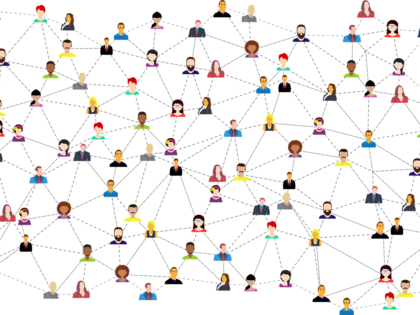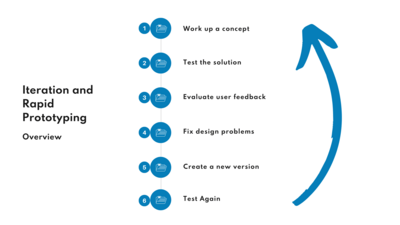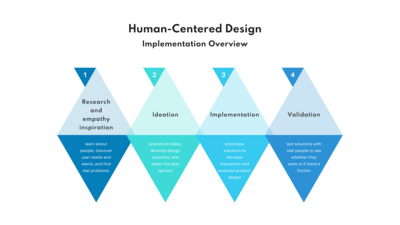Using Human-Centered Design to Put People First

A good product or service solves a customer’s problem. A great product or service solves a greater problem or pain the customer didn’t even know they had.
The latter refers to human-centered design (HCD), which people often confuse with user-centered design (UCD).
Let’s explore the difference between HCD and UCD. Then, we’ll explain why HCD is important and its principles. Finally, we’ll examine the design process and give some HCD examples.
Human-Centered Design (HCD) vs. User-Centered Design (UCD)
People may use HCD and UCD interchangeably, but they are different concepts.
For example, as a user-centered designer, you may ask an end user why they want a product or service and how they’d like it to perform looking at their inherent tendencies. As a human-centered designer, you go beyond the customer’s assumed problem. You ask questions about the person’s pain points, get to the root of the real issue, and reinvent solutions based on this newfound perspective.

UCD makes a solution functional for users, while HCD creates a personalized solution for humans.
Why Is HCD Important?
HCD methodology considers the person as a whole—not just their relationship to your product or service and the way they interact with it. When conducting user research, you analyze why your target audience buys your product/service and how they use it. When studying humans, you uncover insights and opportunities to solve underlying problems based on who they are and what they truly value.

HCD cuts out the yes/no questions that limit feedback. Instead, you ask open-ended questions to reveal broader issues. You get more details about your personas’ problems because HCD moves past the surface of user interface requirements. Higher-level insights then lead to better-informed design decisions, integrating human feedback at every step of the development and testing process.
Learn how to select the best website development and design agency for you.
What Are the Principles of HCD?
The principles of HCD begin with the belief that people should be at the center of every design process. This concept means the development process starts with a deep understanding of the people using your product or service. It’s not enough that the solution functions well. The product or service must achieve the person’s goals.

HCD aims to solve human beings’ real-world problems—not perceived problems. As a human-centered designer, you must keep asking, “Why?” With this series of questions, you dig deeper than the warning signs to find the person’s fundamental problem. Rectifying the main issue eliminates the cause and symptoms.
HCD is a design system—not a collection of features. This idea builds on technical perspectives, adding deeper insights to craft a bigger picture. With a holistic view of your design, you see beyond the lens of your product or service capabilities. You understand the entire user journey. Here, optimizing each touchpoint to impact the overall user experience delivers the maximum value.
HCD relies on cycles of continuous iteration of a product or service based on people’s feedback. With rapid prototyping, you can:
-
Work up a concept
-
Test the solution
-
Evaluate user feedback
-
Fix design problems
-
Create a new version
-
Test again
This cycle of continuous iteration and testing naturally refines your product or service until you arrive at the best fitting solution.
Following these HCD principles enables you to create a UX design that people need vs. what you (or they) think they want.
How Do I Implement an HCD Approach?
An HCD approach combines customer empathy, creative problem-solving, and business success.

Phases of an HCD approach include:
-
Research and empathy inspiration—learn about people, discover user needs and wants, and find real problems.
-
Ideation—brainstorm ideas, develop design solutions, and select the best options
-
Implementation—prototype solutions to simulate interaction and evaluate product design
-
Validation—test solutions with real people to see whether they work or if there’s friction
Failure is part of the process. HCD depends on experimentation in the design approach to create opportunities. Your solution improves by gathering feedback, addressing usability, and testing prototypes.
HCD and Growth-Driven Design (GDD)
In application, the HCD approach can be applied to a variety of digital marketing and development projects, aligning with innovative strategies like growth-driven design (GDD). A methodology and approach to embracing continuous research, phases of prototyping, and user testing. Speaking at a high level, HCD mirrors the GDD stages of strategy, launch, and continuous improvements. HCD and GDD both allow for iterative modifications according to changing user demands over time that are measured and implemented to track growth in real-time.
HCD Examples
You may be using an HCD product or service and not even know it! Here are examples from three popular apps: Uber, Spotify, and Venmo.

Uber
The Uber concept began in 2008 when two friends attending a conference in Paris couldn’t hail a cab. The founders developed the app the next year in San Francisco. In 2010, the first customer took an Uber across the Golden City. The company launched in Paris three years after the idea was born. Today, more than 90 million customers in over 70 countries use Uber.
On the surface, Uber solves a transportation problem. A driver takes you from Point A to Point B. While a taxi meets that basic human need, ride-sharing services like Uber go further.
Arrival: Flagging down an empty cab on the street takes time, especially in a big city. Once you request an Uber, you know when the driver will pick you up and can plan accordingly.
Cost: A taxi driver could take a long way to your destination and drive up the expense. With Uber, you get peace of mind prepaying a set fee no matter the route or length of ride.
Experience: You can talk to a cab driver’s employer if you have a terrible encounter. But your complaint may not change their behavior. On the Uber app, riders and drivers publicly rate each other. With this information, you may decide to accept a ride or look for another driver.
Spotify
Spotify started in response to a growing piracy problem in the music industry. The founders created the platform in 2006 to offer fans music while compensating the artists. Spotify launched two years later. Users could listen for free with ads or buy a commercial-free monthly subscription. Now more than 180 million people subscribe to Spotify.
Spotify lets you listen to music. So do CDs, iPods, and the radio. But Spotify takes customization to a new level.
Before streaming services, you had to buy songs and albums to download on your MP3 player or smartphone. With Spotify, you pay a set price each month for access to millions of songs. You don’t have to make individual purchases to add music to your library.
Music mobility was also an issue before the digital age. Carrying CDs around was cumbersome, but at least you could play music in your car or at a friend’s house. You can play music everywhere with Spotify if you have the app and an internet connection.
Venmo
Did you know Venmo has musical roots? Its original intent in 2009 was to let people pay bands for song or show downloads. But when the founders visited each other for the weekend, and one man forgot his wallet, they expanded the idea. At first, Venmo users paid each other via text. When the founders noticed users were telling stories about their purchases, they added the social network aspect. Venmo now helps 65 million users exchange money.
People use Venmo to give each other money. Before mobile payment services, we repaid friends and family by exchanging cash or writing checks. Venmo makes the process easier.
You don’t have to carry cash or pledge to pick up the next tab to pay back a friend for lunch. Venmo lets you electronically transfer the amount you owe with a few clicks. Likewise, your brother doesn’t have to find his checkbook to repay you for concert tickets. Instead, he can use Venmo to drop some cash into your account.
Get UX tips to boost your site today
Conclusion
With HCD, you get to the bottom of your customers’ struggles and concerns. Infusing empathy and optimization into the design process creates solutions that address the heart of the matter.
O8 can help you approach website design with a human-centric mindset. We show you how to close the gap between what users want and what humans need.
Contact us to learn more about redesigning your website to enhance customer experience.

